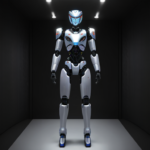In the dynamic landscape of industrial automation, where efficiency, productivity, and cost-effectiveness are essential, motion control stands as a driving force that is revolutionizing the way industries operate. From assembly lines to logistics, motion control technology is transforming industrial processes, streamlining operations, and optimizing outcomes like never before.
The Backbone of Automation
Motion control serves as the backbone of industrial automation, providing the means to regulate and synchronize the movements of machines, conveyors, robotic arms, and more. It’s the engine that powers precision-driven operations, ensuring that complex tasks are executed flawlessly, often in high-speed and high-demand environments. This is achieved through the use of high tolerance bearing components, such as angular contact ball bearings and 4-point contact ball bearings.
Enhancing Efficiency
One of the primary goals of industrial automation is to enhance efficiency, and motion control plays a pivotal role in achieving this objective. By fine-tuning the movements of machines and processes, motion control systems minimize wastage, reduce energy consumption, and optimize the utilization of resources. This results in increased production rates, reduced operational costs, and ultimately, improved profit margins.
Low friction in bearings and rod ends is achieved by production very low operational torque.
Precision Engineering
Industries such as automotive manufacturing, electronics assembly, and pharmaceuticals require an extraordinary level of precision. Motion control systems equipped with advanced sensors, feedback mechanisms, and closed-loop control algorithms ensure that components are positioned, assembled, and tested with utmost accuracy. This level of precision not only ensures product quality but also reduces defects and rework, leading to higher customer satisfaction.
Robotic Flexibility and Adaptability
In today’s fast-paced industrial landscape, adaptability is key. Motion control technology allows for quick reprogramming and reconfiguration of machines and processes, enabling industries to pivot rapidly in response to market demands. Whether it’s adjusting the assembly sequence or accommodating a new product variant, motion control ensures that changes can be seamlessly implemented without major disruptions.
Humanoid Safety and Ergonomics
Industrial automation is not just about efficiency; it’s also about creating safer and more ergonomic work environments. Motion control systems can be integrated with safety features such as collision avoidance sensors, emergency stop mechanisms, and protective barriers. By minimizing the risk of accidents and reducing the physical strain on workers, motion control contributes to improved workplace safety and employee well-being.
Real-time Monitoring and Analysis
The integration of motion control with data analytics tools opens up new avenues for real-time monitoring and analysis. By collecting data on machine performance, movement patterns, and energy consumption, industries can gain insights into operational trends and identify areas for further optimization. Predictive maintenance, for instance, becomes possible, as anomalies in motion control behavior can signal potential issues before they escalate.
Challenges and Innovations
Implementing motion control in industrial automation does come with challenges. Integration with existing systems, tuning for optimal performance, and mitigating mechanical vibrations are some of the hurdles to overcome. However, the field is marked by continuous innovation. Advanced control algorithms, machine learning, and AI are being harnessed to enhance motion control’s adaptability, precision, and predictive capabilities.
The Future Landscape
The future of motion control in industrial automation is poised for remarkable growth. As industries continue to embrace the principles of Industry 4.0, motion control will play a pivotal role in creating smart factories where machines communicate, self-optimize, and operate with minimal human intervention. The rise of collaborative robots (cobots) that work alongside human workers is also driven by sophisticated motion control systems that ensure safe and efficient interactions.
The technology in motion control is reshaping the industrial automation landscape. By enabling precision, enhancing efficiency, and driving innovation, motion control is at the forefront of the transformation towards smarter, safer, and more productive industries.
As industries continue to evolve, the synergy between motion control and automation will undoubtedly lead to new frontiers of excellence, where machines and humans collaborate seamlessly to achieve remarkable feats of productivity and innovation.


